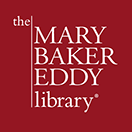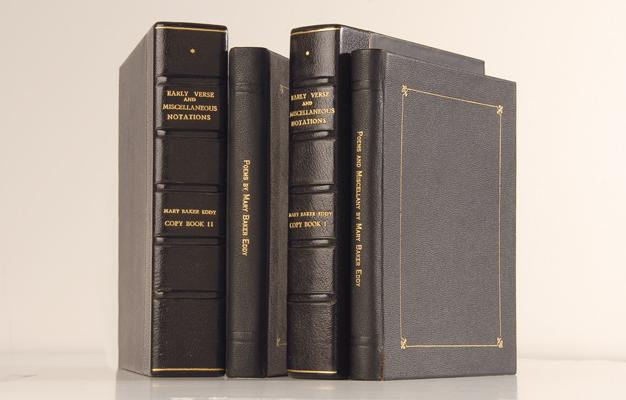Two of Mary Baker Eddy’s copybooks and their slipcovers are shown here.
Copybooks were frequently used in the first half of the nineteenth century. The Oxford English Dictionary tells us that they are books in which “copies are written or printed for pupils to imitate” (1971 printing). They were used by students, teachers, writers, and working professionals for practicing penmanship, learning grammar, and spelling, with a focus on accuracy, attention to detail, and memory. It is not surprising that Mary Baker Eddy, always a writer, used copybooks from her teenage years to practice her writing technique as well as to note down her own thoughts, ideas, and poetry. What is surprising is that she held onto two of them, referring to them and even re-editing the poems in them many years later.
As good penmanship was critical in the 1800s, practice was essential. Typewriters were not in common use until the last decades of the century and printing was generally expensive and uncommon. Nothing like word processing existed, leaving men and women to practice their handwriting so it was legible for others to read. Penmanship was especially valued in New England, as one historian tells us:
As the nineteenth century opened Boston was still very much the American center of literature and education. The masters of its writing schools, inheriting a fine colonial tradition that produced work worthy of old-country-bred penmen, were admired and envied everywhere.1
Looking at Eddy’s copybooks we can see that her early handwriting was quite neat. In her later years, her handwriting became much less legible, probably due to a heavy workload that often involved hours of writing. Her handwriting in the copybooks is also rather small. Paper was expensive in those days, so writers probably wanted to get as much content as possible on each page.
But fine penmanship was not the reason Mary Baker Eddy saved her copybooks! She valued them because they contained numerous original poems. Many decades after writing them, Eddy went back to review and re-edit her poems. Some of these were then published at the very end of her life in her 1910 book Poems. Here’s one example:
CONSTANCY
When starlight blends with morning’s hue,
I miss thee as the flower its dew!
When noonday’s length’ning shadows flee,
I think of thee, I think of thee!With evening, memories reappear—
I watch thy chair, and wish thee here;
Till sleep sets drooping fancy free
To dream of thee, to dream of thee!Since first we met, in weal or woe
It hath been thus; and must be so
Till bursting bonds our spirits part
And Love divine doth fill my heart.2
This poem was originally written in one of Eddy’s copybooks with the title “To My Absent Husband.” There are two versions in the same copybook, the second one with the heading “Written Feb 1856 during sickness.” This poem was first published in 1903 in the book The Fruit of the Spirit Poetically Interpreted, a compilation of poetry assembled by Alice Jennings.


